Aruba

Aruba

Aruba | |
|---|---|
Constituent country in the Kingdom of the Netherlands | |
| Anthem: "Aruba Dushi Tera" (English:"Aruba, Sweet Land") | |
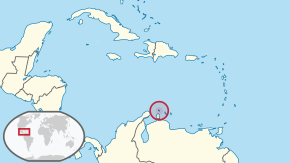 Location of Aruba (circled in red) | |
| Sovereign state | Kingdom of the Netherlands |
| Before separation | Netherlands Antilles |
| Country status | 1 January 1986 |
| Capital and largest city | Oranjestad 12°31′07″N 70°02′09″W [58] |
| Official languages | |
| Ethnic groups (2010) | 66% Aruban 9.1% Colombian 4.3% Dutch 4.1% Dominican 3.2% Venezuelan 2.2% Curaçaoan 1.5% Haitian 1.1% Peruvian 1.1% Chinese 6.2% other[2] |
| Demonym(s) | Aruban |
| Government | Parliamentary representative democracy within a constitutional monarchy |
• Monarch | Willem-Alexander |
• Governor | Alfonso Boekhoudt |
• Prime Minister | Evelyn Wever-Croes |
| Legislature | Estates of Aruba |
| Area | |
• Total | 178.91 km2(69.08 sq mi) |
• Water (%) | negligible |
| Highest elevation | 188 m (617 ft) |
| Population | |
• 2016 estimate | 104,822[3] (197th) |
• Density | 612/km2(1,585.1/sq mi) (22nd) |
| GDP(PPP) | 2019 estimate |
• Total | $4.483 billion |
• Per capita | $40,160[4] |
| GDP(nominal) | 2019 estimate |
• Total | $2.875 billion |
• Per capita | $25,750[4] |
| HDI(2013) | 0.908 very high |
| Currency | Aruban florin (AWG) |
| Time zone | UTC-4:00 (AST) |
| Driving side | right |
| Calling code | +297 |
| ISO 3166 code |
|
| Internet TLD | .aw |
Aruba (/əˈruːbə/ ə-ROO-bə, Dutch: [aːˈrubaː, -ryb-] (listen), Papiamento: [aˈruba]) is an island and a constituent country of the Kingdom of the Netherlands in the southern Caribbean Sea, located about 1,600 kilometres (990 mi) west of the main part of the Lesser Antilles and 29 kilometres (18 mi)[5] north of the coast of Venezuela. It measures 32 kilometres (20 mi) long from its northwestern to its southeastern end and 10 kilometres (6 mi) across at its widest point.[5] Together with Bonaire and Curaçao, Aruba forms a group referred to as the ABC islands. Collectively, Aruba and the other Dutch islands in the Caribbean are often called the Dutch Caribbean.
Aruba is one of the four countries that form the Kingdom of the Netherlands, along with the Netherlands, Curaçao, and Sint Maarten; the citizens of these countries are all Dutch nationals.[6] Aruba has no administrative subdivisions, but, for census purposes, is divided into eight regions. Its capital is Oranjestad.[6][5]
Unlike much of the Caribbean region, Aruba has a dry climate and an arid, cactus-strewn landscape.[5][6] This climate has helped tourism as visitors to the island can reliably expect warm, sunny weather. It has a land area of 179 km2 (69.1 sq mi) and is densely populated, with a total of 102,484 inhabitants at the 2010 Census. Current estimates of the population place it at 116,600 (July 2018 est.)[6] It lies outside Hurricane Alley.[6]
Aruba | |
|---|---|
Constituent country in the Kingdom of the Netherlands | |
| Anthem: "Aruba Dushi Tera" (English:"Aruba, Sweet Land") | |
 Location of Aruba (circled in red) | |
| Sovereign state | Kingdom of the Netherlands |
| Before separation | Netherlands Antilles |
| Country status | 1 January 1986 |
| Capital and largest city | Oranjestad 12°31′07″N 70°02′09″W [58] |
| Official languages | |
| Ethnic groups (2010) | 66% Aruban 9.1% Colombian 4.3% Dutch 4.1% Dominican 3.2% Venezuelan 2.2% Curaçaoan 1.5% Haitian 1.1% Peruvian 1.1% Chinese 6.2% other[2] |
| Demonym(s) | Aruban |
| Government | Parliamentary representative democracy within a constitutional monarchy |
• Monarch | Willem-Alexander |
• Governor | Alfonso Boekhoudt |
• Prime Minister | Evelyn Wever-Croes |
| Legislature | Estates of Aruba |
| Area | |
• Total | 178.91 km2(69.08 sq mi) |
• Water (%) | negligible |
| Highest elevation | 188 m (617 ft) |
| Population | |
• 2016 estimate | 104,822[3] (197th) |
• Density | 612/km2(1,585.1/sq mi) (22nd) |
| GDP(PPP) | 2019 estimate |
• Total | $4.483 billion |
• Per capita | $40,160[4] |
| GDP(nominal) | 2019 estimate |
• Total | $2.875 billion |
• Per capita | $25,750[4] |
| HDI(2013) | 0.908 very high |
| Currency | Aruban florin (AWG) |
| Time zone | UTC-4:00 (AST) |
| Driving side | right |
| Calling code | +297 |
| ISO 3166 code |
|
| Internet TLD | .aw |
Etymology
History
Pre-colonial era
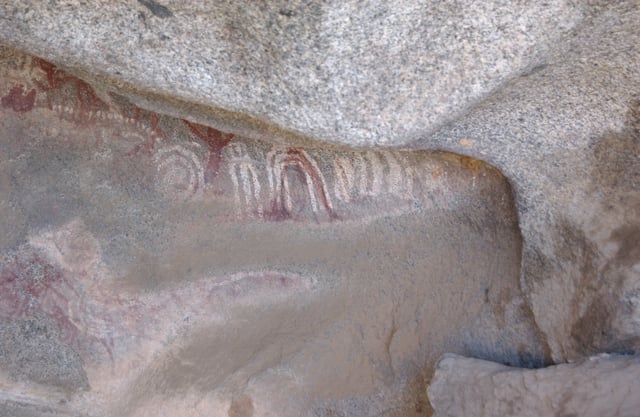
Arawak petroglyphs in the Ayo Rocks
There has been a human presence on Aruba from as early as circa 2000 BC.[8] The first identifiable group are the Arawak Caquetío Amerindians who migrated from South America about 1000 AD.[8][9] Archaeological evidence suggests continuing links between these native Arubans and Amerindian peoples of mainland South America.[7]
Arrival of Europeans and Spanish period
The first Europeans to visit Aruba were Amerigo Vespucci and Alonso de Ojeda in 1499, who claimed the island for Spain.[8] Both men described Aruba as an "island of giants", remarking on the comparatively large stature of the native Caquetíos.[7] Vespucci returned to Spain with stocks of cotton and brazilwood from the island and described houses built into the ocean. Vespucci and Ojeda's tales spurred interest in Aruba, and the Spanish began colonising the island.[10][11] Alonso de Ojeda was appointed the island's first governor in 1508. From 1513 the Spanish began enslaving the Caquetíos, sending many to a life of forced labour in the mines of Hispaniola.[7][8] The island's low rainfall and arid landscape meant that it was not considered profitable for a slave-based plantation system and the type of large-scale slavery so common on other Caribbean islands never became established on Aruba.[12]
Early Dutch period
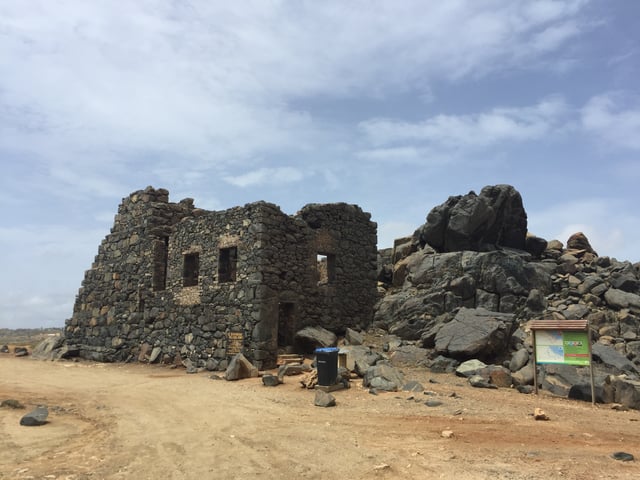
Remains of a gold mine at Bushiribana
The Netherlands seized Aruba from Spain in 1636 in the course of the Thirty Years' War.[5][8] Peter Stuyvesant, later appointed to New Amsterdam (New York), was the first Dutch governor. Those Arawak who had survived the depredations of the Spanish were allowed to farm and graze livestock, with the Dutch using the island as a source of meat for their other possessions in the Caribbean.[7][8] Aruba's proximity to South America resulted in interactions with the cultures of the coastal areas; for example, architectural similarities can be seen between the 19th-century parts of Oranjestad and the nearby Venezuelan city of Coro in Falcón State. Historically, Dutch was not widely spoken on the island outside of colonial administration; its use increased in the late 19th and early 20th centuries.[13] Students on Curaçao, Aruba, and Bonaire were taught predominantly in Spanish until the late 18th century.[14]
During the Napoleonic Wars the British Empire took control of the island, occupying it between 1806 and 1816, before handing it back to the Dutch as per the terms of the Anglo-Dutch Treaty of 1814.[7][5][15][8] Aruba subsequently became part of the Colony of Curaçao and Dependencies along with Bonaire. During the 19th century an economy based on gold mining, phosphate production and aloe vera plantations developed, however the island remained a relatively poor backwater.[7]
20th-21st centuries
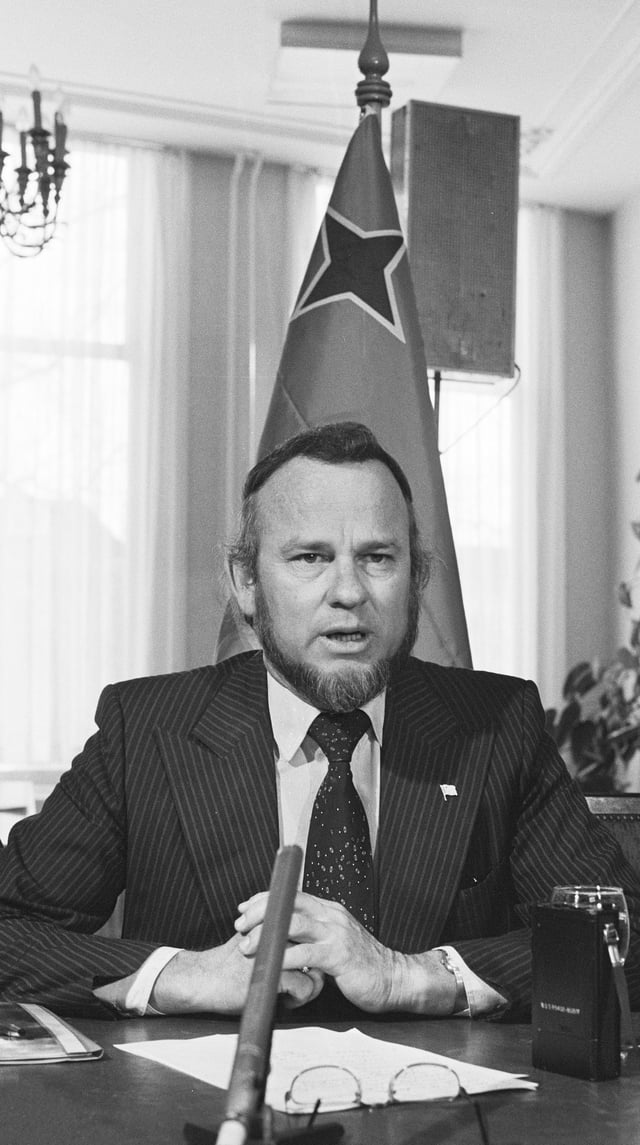
Bettico Croes, a pivotal figure in Aruba's drive for greater autonomy in the 1970s-80s
In August 1947 Aruba presented its first Staatsreglement (constitution) for Aruba's status aparte as an autonomous state within the Kingdom of the Netherlands, prompted by the efforts of Henny Eman, a noted Aruban politician. By 1954 the Charter of the Kingdom of the Netherlands was established, providing a framework for relations between Aruba and the rest of the Kingdom.[18] This created the Netherlands Antilles which united all of the Dutch colonies in the Caribbean into one administrative structure.[19] Many Arubans were unhappy at the arrangement however, as the new polity was perceived as being dominated by Curaçao.[5]
In 1972 at a conference in Dutch Guiana, Betico Croes, a politician from Aruba, proposed the creation of a Dutch Commonwealth of four states: Aruba, the Netherlands, Suriname and the Netherlands Antilles, each to have its own nationality. Backed by his newly-created party (the Movimiento Electoral di Pueblo), Croes sought greater autonomy for Aruba, with the long-term goal of independence, adopting the trappings of an independent state in 1976 with the creation of a flag and national anthem.[7] In March 1977 a referendum was held with the support of the United Nations; 82% of the participants voted for complete independence from the Netherlands.[7][20] Tensions mounted as Croes stepped up the pressure on the Dutch government by organising a general strike in 1977.[7] Croes later met with Dutch Prime Minister Joop den Uyl, with the two sides agreeing to assign the Institute of Social Studies in The Hague to prepare a study for independence, entitled Aruba en Onafhankelijkheid, achtergronden, modaliteiten en mogelijkheden; een rapport in eerste aanleg (Aruba and independence, backgrounds, modalities and opportunities; a preliminary report) (1978).[7]
In March 1983, Aruba reached an official agreement within the Kingdom for its independence, to be developed in a series of steps as the Crown granted increasing autonomy. In August 1985 Aruba drafted a constitution that was unanimously approved. On 1 January 1986, after elections were held for its first parliament, Aruba seceded from the Netherlands Antilles, officially becoming a country of the Kingdom of the Netherlands, with full independence planned for 1996.[7] However Croes was seriously injured in a traffic accident in 1985, slipping into a coma; he died in 1986, never seeing the enaction of status aparte for Aruba for which he had worked over many years.[7] After his death in 1986, Croes was proclaimed Libertador di Aruba.[7] Thus Henny Eman of the Aruban People's Party (AVP) became the first Prime Minister of Aruba. Meanwhile, Aruba's oil refinery shut, negatively impacting the economy. As a result, Aruba pushed for a dramatic increase in tourism, with this sector growing to become the island's largest industry.[7]
At a convention in The Hague in 1990, at the request of Aruba's Prime Minister Nelson Oduber, the governments of Aruba, the Netherlands, and the Netherlands Antilles postponed indefinitely Aruba's transition to full independence.[7] The article scheduling Aruba's complete independence was rescinded in 1995, although the process could be revived after another referendum.
Geography

A map of Aruba

Map of Aruba from the Encyclopaedie van Nederlandsch West-Indië 1914-1917
Aruba is a generally flat, riverless island in the Leeward Antilles island arc of the Lesser Antilles in the southern part of the Caribbean. It lies circa 48 miles east of Curaçao and 18 miles north of Venezuela's Paraguaná Peninsula.[5] Aruba has white sandy beaches on the western and southern coasts of the island, relatively sheltered from fierce ocean currents.[5][21] This is where the bulk of the population live and where most tourist development has occurred.[21][6] The northern and eastern coasts, lacking this protection, are considerably more battered by the sea and have been left largely untouched.
The Natural Bridge was a large, naturally formed limestone bridge on the island's north shore. It was a popular tourist destination until its collapse in 2005.
Cities and towns
The island, with a population of about 116,600 people (July 2018 est.)[6] does not have major cities. It is divided into six districts.[22] Most of the island's population resides in or around the two major city-like districts of Oranjestad (the capital) and San Nicolaas. Oranjestad and San Nicolaas are both divided into two districts for census purposes only.[23] The districts are as follows:
Noord
Oranjestad
Paradera
San Nicolaas
Santa Cruz
Savaneta
Fauna
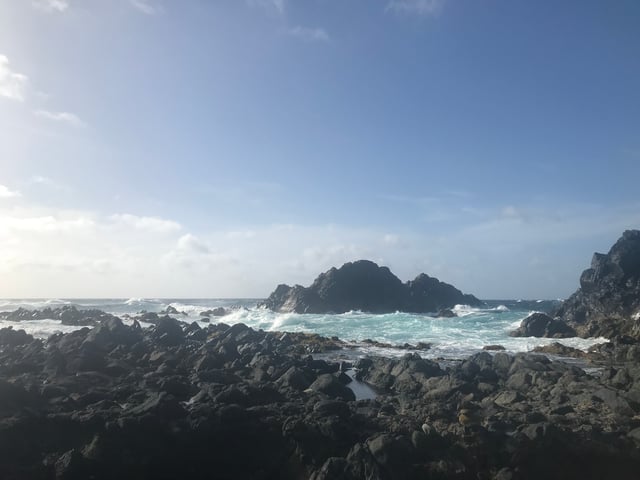
Natural Pool in Santa Cruz
The isolation of Aruba from the mainland of South America has fostered the evolution of multiple endemic animals. The island provides a habitat for the endemic Aruban Whiptail and Aruba Rattlesnake, as well as an endemic subspecies of Burrowing Owl and Brown-throated Parakeet.
Flora
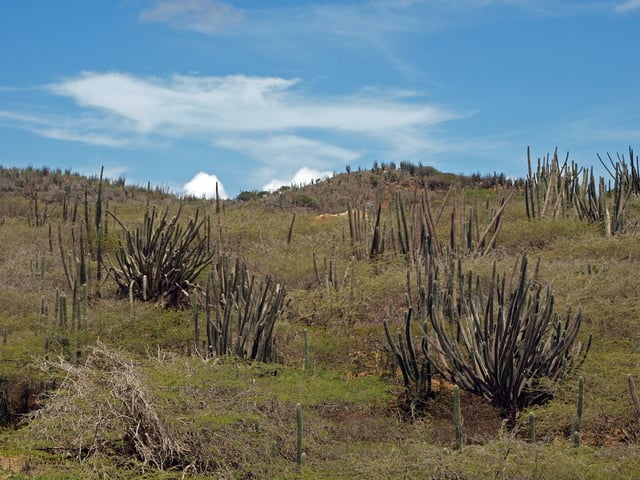
Cacti in Arikok National Park
The flora of Aruba differs from the typical tropical island vegetation. Xeric scrublands are common, with various forms of cacti, thorny shrubs, and evergreens.[5] Aloe vera is also present, its economic importance earning it a place on the Coat of Arms of Aruba.
Climate
By the Köppen climate classification, Aruba has a hot semi-arid climate (Köppen BSh).[24] Mean monthly temperature in Oranjestad varies little from 26.7 °C (80.1 °F) to 29.2 °C (84.6 °F), moderated by constant trade winds from the Atlantic Ocean, which come from the north-east. Yearly rainfall barely exceeds 470 millimetres or 18.5 inches in Oranjestad, although it is extremely variable[25] and can range from as little as 150 millimetres or 5.91 inches during strong El Niño years (e.g. 1911/1912, 1930/1931, 1982/1983, 1997/1998) to over 1,000 millimetres or 39.37 inches in La Niña years like 1933/1934, 1970/1971 or 1988/1989.
Demographics
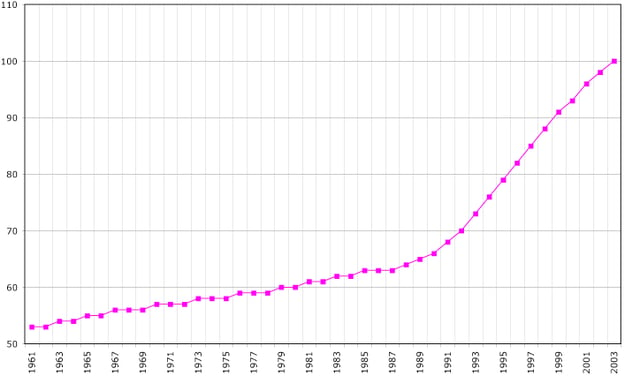
Population of Aruba 1961–2003, according to the FAO in 2005; number of inhabitants given in thousands
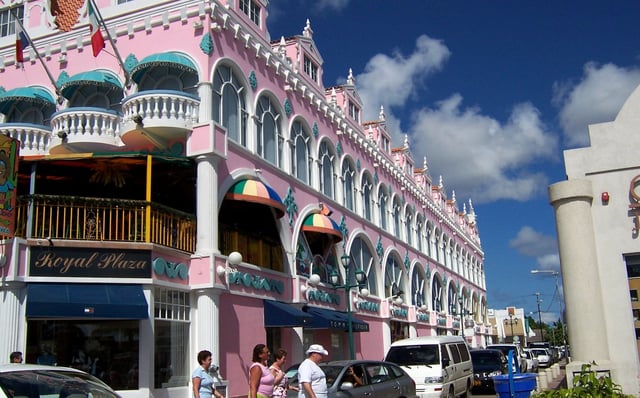
The capital Oranjestad
In terms of country of birth, the population is estimated to be 66% Aruban, 9.1% Colombian, 4.3% Dutch, 4.1% Dominican, 3.2% Venezuelan, 2.2% Curaçaoan, 1.5% Haitian, 1.1% Peruvian, 1.1% Chinese, 6.2% other.[2]
In terms of ethnic composition, the population is estimated to be 75% mixed European/Amerindian/African, 15% Black and 10% other ethnicities. Arawak heritage is stronger on Aruba than on most Caribbean islands; although no full-blooded Aboriginals remain, the features of the islanders clearly indicate their genetic Arawak heritage. Most of the population is descended from Caquetio Indians and Dutch settlers, and to a lesser extent the various other groups that have settled on the island over time, such as various African peoples, Spanish, Portuguese, English, French, and Sephardic Jews.
Recently, there has been substantial immigration to the island from neighbouring South American and Caribbean nations, attracted by the higher paid jobs. In 2007, new immigration laws were introduced to help control the growth of the population by restricting foreign workers to a maximum of three years residency on the island. Most notable are Venezuelans, which lies just 18 miles to the south. Many of Arubans have Venezuelan ancestry and there is a seasonal increase of Venezuelans living in second homes.
Language
The official languages are Dutch and Papiamento. However, whilst Dutch is the sole language for all administration and legal matters,[27] Papiamento is the predominant language used on Aruba. It is a creole language, spoken on Aruba, Bonaire, and Curaçao, that incorporates words from Portuguese, various West African languages, Dutch and Spanish.[5] English is also spoken, its usage having grown due to tourism.[5][6] Other common languages spoken, based on the size of their community, are Portuguese, Chinese, German, Spanish, and French.
In recent years the government of Aruba has shown an increased interest in acknowledging the cultural and historical importance of Papiamento. Although spoken Papiamento is fairly similar among the several Papiamento-speaking islands, there is a big difference in written Papiamento. The orthography differs per island, with Aruba using etymological Papiamento, and Curaçao and Bonaire a phonetic Papiamento. Some are more oriented towards Portuguese and use the equivalent spelling (e.g. "y" instead of "j"), where others are more oriented towards Dutch.
The book Buccaneers of America, first published in 1678, states through eyewitness account that the natives on Aruba spoke Spanish already. Spanish became an important language in the 18th century due to the close economic ties with Spanish colonies in what are now Venezuela and Colombia.[28] Venezuelan TV networks are received on the island, and Aruba also has significant Venezuelan and Colombian communities. Around 12.6% of the population today speaks Spanish.[29] Use of English dates to the early 19th century, when the British took Curaçao, Aruba and Bonaire. When Dutch rule resumed in 1815, officials already noted wide use of the language.[13]
Aruba has four newspapers published in Papiamento: Diario, Bon Dia, Solo di Pueblo and Awe Mainta; and three in English: Aruba Daily, Aruba Today and The News. Amigoe is a newspaper published in Dutch. Aruba also has 18 radio stations (two AM and 16 FM) and two local television stations (Telearuba, and Channel 22).
Religion
Regions
For census purposes, Aruba is divided into eight regions, which have no administrative functions:
| Name | Area (km²) | Population 1991 Census | Population 2000 Census | Population 2010 Census |
|---|---|---|---|---|
| Noord / Tanki Leendert | 34.62 | 10,056 | 16,944 | 21,495 |
| Oranjestad West | 9.29 | 8,779 | 12,131 | 13,976 |
| Oranjestad Oost | 12.88 | 11,266 | 14,224 | 14,318 |
| Paradera | 20.49 | 6,189 | 9,037 | 12,024 |
| San Nicolas Noord | 23.19 | 8,206 | 10,118 | 10,433 |
| San Nicolas Zuid | 9.64 | 5,304 | 5,730 | 4,850 |
| Santa Cruz | 41.04 | 9,587 | 12,326 | 12,870 |
| Savaneta | 27.76 | 7,273 | 9,996 | 11,518 |
| Total Aruba | 178.91 | 66,687 | 90,506 | 101,484 |
Government

Map of the European Union in the world with overseas countries and territories and outermost regions
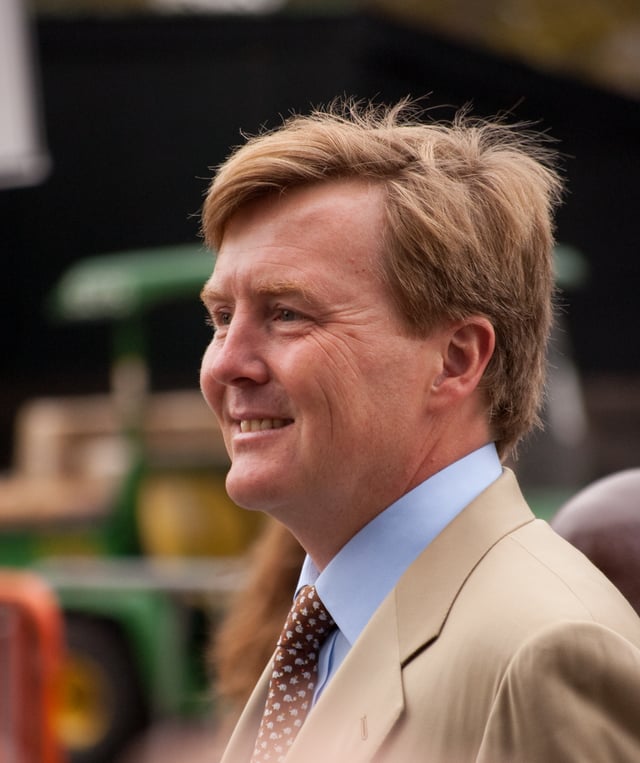
King Willem-Alexander is the head of state of Aruba
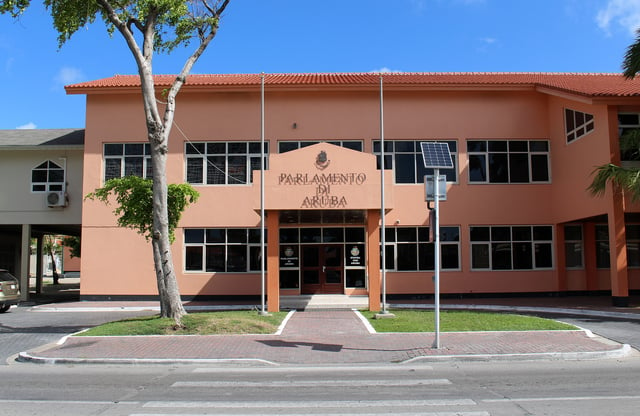
Parliament of Aruba in Oranjestad
Along with the Netherlands, Curaçao and Sint Maarten, Aruba is a constituent country of the Kingdom of the Netherlands, with internal autonomy.[6] Matters such as foreign affairs and defence are handled by the Netherlands.[6] Aruba's politics take place within a framework of a 21-member Staten (Parliament) and an eight-member Cabinet; the Staten's 21 members are elected by direct, popular vote to serve a four-year term.[5][30] The governor of Aruba is appointed for a six-year term by the monarch, and the prime minister and deputy prime minister are indirectly elected by the Staten for four-year terms.[6]
Politics
The Aruban legal system is based on the Dutch model. In Aruba, legal jurisdiction lies with the Gerecht in Eerste Aanleg (Court of First Instance) on Aruba, the Gemeenschappelijk Hof van Justitie van Aruba, Curaçao, Sint Maarten en van Bonaire, Sint Eustatius en Saba (Joint Court of Justice of Aruba, Curaçao, Sint Maarten, and of Bonaire, Sint Eustatius and Saba) and the Hoge Raad der Nederlanden (Supreme Court of Justice of the Netherlands).[33] The Korps Politie Aruba (Aruba Police Force) is the island's law enforcement agency and operates district precincts in Oranjestad, Noord, San Nicolaas, and Santa Cruz, where it is headquartered.[34]
Deficit spending has been a staple in Aruba's history, and modestly high inflation has been present as well. By 2006 the government's debt had grown to 1.883 billion Aruban florins.[35] In 2006 the Aruban government changed several tax laws to reduce the deficit. Direct taxes have been converted to indirect taxes as proposed by the IMF.
Foreign Relations
Like Bonaire and a few other Dutch dependencies, Aruba maintains economic and cultural relations with Taiwan via Taipei Economic and Cultural Office in Canada.
Military
Defence on Aruba is the responsibility of the Kingdom of the Netherlands.[6] The Netherlands Military forces that protect Aruba include the Royal Netherlands Navy, the Netherlands Marine Corps and the Netherlands Coastguard. There is also a small "Arubaanse Militie" (ARUMIL) of about platoon strength.
All forces are stationed at Marines Barracks Savaneta. Furthermore, in 1999 the U.S. Department of Defense established a Forward Operating Location (FOL) at the airport.[36]
Education
Aruba's educational system is patterned after the Dutch system of education.[37] The Government of Aruba finances the public national education system.
Economy
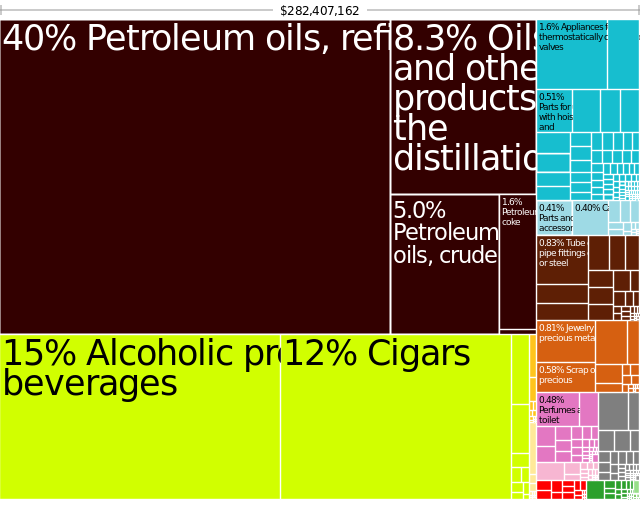
A graphical breakdown of Aruba's economy by exports
The island's economy is dominated by four main industries: tourism, aloe export, petroleum refining and offshore banking.[6][5] Aruba has one of the highest standards of living in the Caribbean region. The GDP per capita for Aruba was estimated to be $37,500 in 2017.[42] Its main trading partners are Colombia, the United States, Venezuela, and the Netherlands.
The agriculture and manufacturing sectors are fairly minimal. Gold mining was formerly important in the 19th century.[5] Aloe was introduce to Aruba in 1840 but did not become a big export until 1890. Cornelius Eman founded Aruba Aloe Balm and over time the industry became very important to the economy. At one point two thirds of the island was covered in Aloe Vera fields and Aruba become the largest exporter of aloe in the world. The industry continues today though on a smaller scale.
Tourism
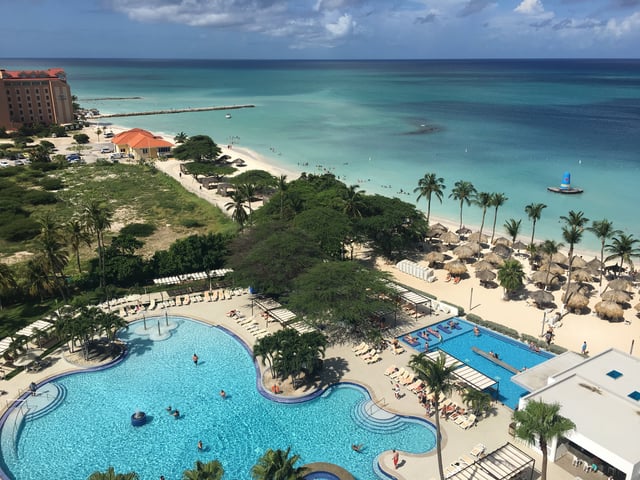
A tourist resort on the island
About three quarters of the Aruban gross national product is earned through tourism and related activities.[45] Most tourists are from North America, with a market-share of 73.3%, followed by Latin America with 15.2% and Europe with 8.3%.[46]
For passengers whose destination is the United States, the United States Department of Homeland Security (DHS), U.S. Customs and Border Protection (CBP) has a full pre-clearance facility in Aruba which has been in effect since 1 February 2001 with the expansion of Queen Beatrix Airport. Since 2008, Aruba has been the only island to have this service for private flights.[47]
Culture
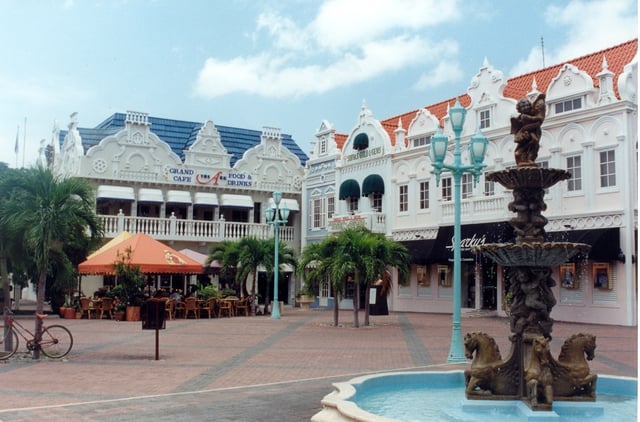
Ornate buildings in Oranjestad
Aruba has a varied culture. According to the Bureau Burgelijke Stand en Bevolkingsregister (BBSB), in 2005 there were ninety-two different nationalities living on the island. Dutch influence can still be seen, as in the celebration of "Sinterklaas" on 5 and 6 December and other national holidays like 27 April, when in Aruba and the rest of the Kingdom of the Netherlands the King's birthday or "Dia di Rey" (Koningsdag) is celebrated.
On 18 March, Aruba celebrates its National Day. Christmas and New Year's Eve are celebrated with the typical music and songs for gaitas for Christmas and the Dande for New Year, and ayaca, ponche crema, ham, and other typical foods and drinks. On 25 January, Betico Croes' birthday is celebrated. Dia di San Juan is celebrated on 24 June. Besides Christmas, the religious holy days of the Feast of the Ascension and Good Friday are also holidays on the island.
The festival of Carnaval is also an important one in Aruba, as it is in many Caribbean and Latin American countries. Its celebration in Aruba started in the 1950s, influenced by the inhabitants from Venezuela and the nearby islands (Curaçao, St. Vincent, Trinidad, Barbados, St. Maarten and Anguilla) who came to work for the oil refinery. Over the years the Carnival Celebration has changed and now starts from the beginning of January till the Tuesday before Ash Wednesday, with a large parade on the last Sunday of the festivities (Sunday before Ash Wednesday).
Tourism from the United States has recently increased the visibility of American culture on the island, with such celebrations as Halloween and Thanksgiving Day in November.
Infrastructure
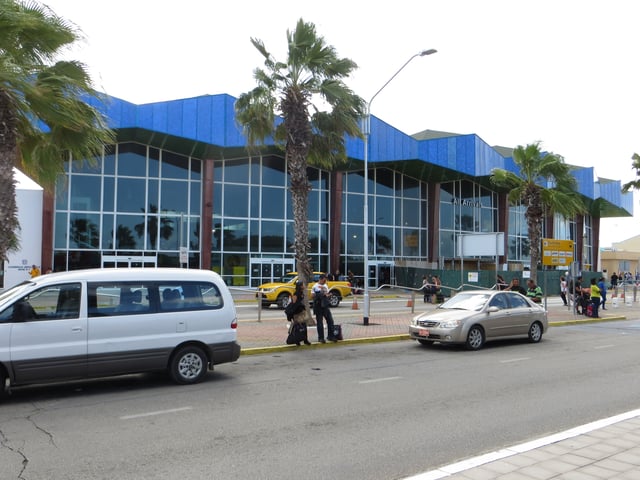
The Arrivals building at Queen Beatrix International Airport
Aruba's Queen Beatrix International Airport is located near Oranjestad.
Aruba has two ports, Barcadera and Playa, which are located in Oranjestad and Barcadera. The Port of Playa services all the cruise-ship lines, including Royal Caribbean, Carnival Cruise Lines, NCL, Holland America Line, Disney Cruise Line and others. Nearly one million tourists enter this port per year. Aruba Ports Authority, owned and operated by the Aruban government, runs these seaports.
Arubus is a government-owned bus company. Its buses operate from 3:30 a.m. until 12:30 a.m., 365 days a year. Small private vans also provide transportation services in certain areas such Hotel Area, San Nicolaas, Santa Cruz and Noord.
A street car service runs on rails on the Mainstreet.[48]
Utilities
Communications
There are two telecommunications providers: Setar, a government-based company and Digicel, both of which are privately owned. Setar is the provider of services such as internet, video conferencing, GSM wireless technology and land lines.[51] Digicel is Setar's competitor in wireless technology using the GSM platform.[52]
Places of interest
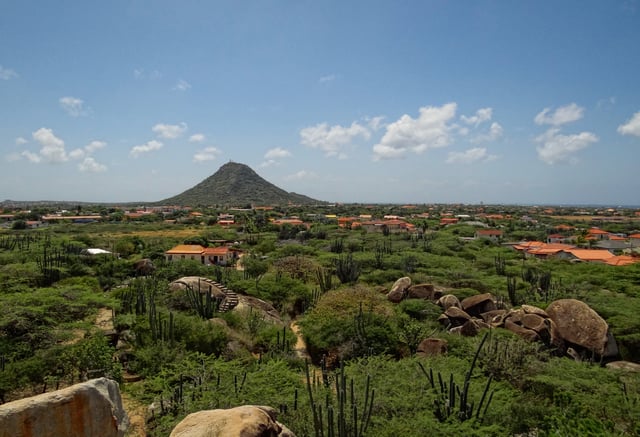
Hooiberg mountain
Alto Vista Chapel
Arikok National Park
Ayo and Casibari Rock Formations
Bushiribana and Balashi
California Lighthouse
Frenchman's Pass
Hooiberg
Mount Jamanota
Natural Pool
Quadiriki Caves
Sint Nicolaas, Aruba
Tierra Del Sol Golf Course
- Beaches
Arashi Beach
Baby Beach, Aruba
Caves of Aruba
Eagle Beach
Palm Beach, Aruba
Palm Island, Aruba
Rodgers Beach, Aruba
Flamingo Beach, Aruba [53]
Notable people
Dave Benton, Aruban-Estonian musician
Alfonso Boekhoudt, 4th Governor of Aruba
Xander Bogaerts, MLB shortstop for the Boston Red Sox
Betico Croes, political activist
Henny Eman, 1st Prime Minister of Aruba
Mike Eman, 3rd Prime Minister of Aruba
Bobby Farrell, musician
Edjean Semeleer, vocalist & philanthropist
Frans Figaroa, Lieutenant Governor of Aruba 1979-1982
Henry Habibe, poet
Andrew Holleran, novelist
Olindo Koolman, 2nd Governor of Aruba
Jossy Mansur, editor of the Papiamento language newspaper, Diario
Nelson Oduber, 2nd Prime Minister of Aruba
Sidney Ponson, MLB pitcher for the Baltimore Orioles, San Francisco Giants, St. Louis Cardinals, New York Yankees, Minnesota Twins, Texas Rangers and Kansas City Royals
Fredis Refunjol, 3rd Governor of Aruba
Julia Renfro, newspaper editor and photographer
Jeannette Richardson-Baars, Director of the Police Academy of Aruba
Felipe Tromp, 1st Governor of Aruba
Evelyn Wever-Croes, 4th Prime Minister of Aruba
Diederick Charles Mathew, politician
See also
Bibliography of Aruba
Central Bank of Aruba
Index of Aruba-related articles
List of monuments of Aruba
Military of Aruba
Outline of Aruba
SS Pedernales

